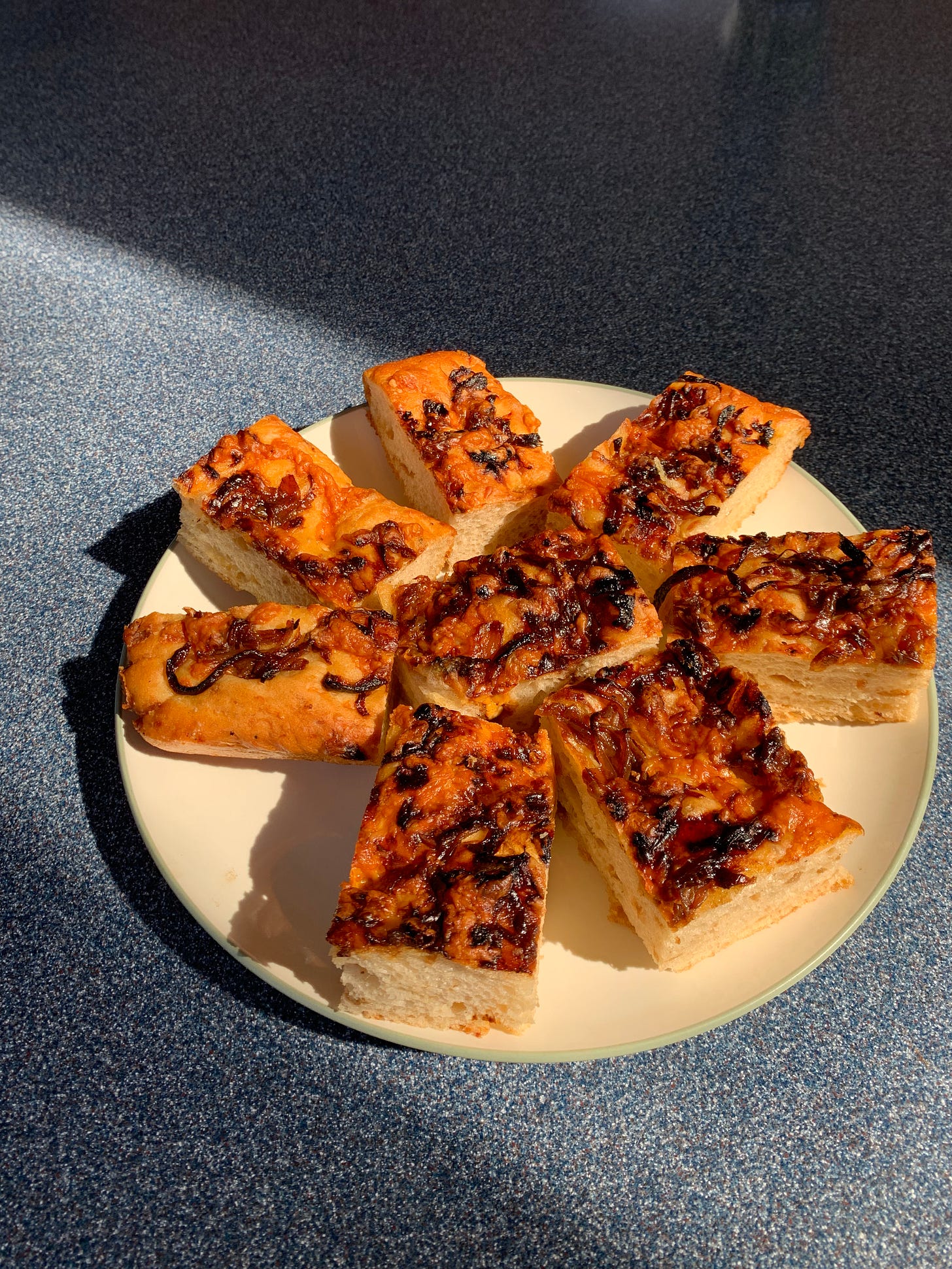Caramelized Onion and Cheddar Focaccia with Pomegranate Molasses
You know the last post, where I went on and on about how perfect my vanilla cake recipe was? Yeah, well, this focaccia took me down a notch.
The recipe
Yield: about 12 servings
Time: 3 and ½ hours
Ingredients
2 large or 3 medium yellow onions
10 g (1 and ½ tsp) salt, divided
375 g (3 cups) flour
7 g (2 tsp) instant yeast
300 g (1 and ¼ c) water
113 g (4 oz or 1 c) sharp cheddar, shredded
20 g (¼ c) olive oil, plus extra for coating pans and bowls
2 tsp pomegranate molasses
Instructions
1. Caramelize the onions: Slice the onions thinly and cook them with ½ tsp (3 g) salt in a large pan over medium-high heat. Stir often at the beginning and constantly toward the end of cooking. Cook until they are medium-brown, about 25 minutes. Set the onions aside in a bowl to cool.
2. Make the dough by putting the flour in the bowl of a stand mixer fitted with the dough hook attachment. Add the yeast to one side and the remaining 1 tsp (7 g) salt to the other side. Add the water and then mix on low speed for about a minute, until the dough starts coming together and there are no large patches of flour on the bottom of the bowl.
3. Increase the speed to medium-high and mix for 10–12 full minutes, until the dough pulls away from the sides and bottom of the mixer and forms a single mass on the hook.
4. Add half of the onions and cheese and mix again on medium-low for a minute or two until they are evenly spread throughout the dough.
5. Thoroughly oil a bowl and your hands, then lift the dough out of the mixer, place it in the bowl, and cover it. Leave it to rise until it has doubled in size, about 1 hour.
6. Once the dough has risen, pour 2 tbsp olive oil on a half sheet tray (mine is 13 x 18 inches) and move it around to coat the bottom and sides evenly. Oil your hands, then transfer the dough to the tray.
7. Gently stretch the dough all the way to the edges of the tray. If it doesn’t fill those edges in, cover it with an oiled piece of plastic wrap, wait 10 minutes, and then stretch it again.
8. Cover the dough with an oiled piece of plastic wrap and let it rise until it doubles again, about another hour. It’s ready to bake when it springs back halfway after you poke it with your finger.
9. While the dough is rising the second time, preheat your oven to 450°F and place a rack on the bottommost spot.
10. When the dough has finished rising, coat your fingers in olive oil and poke it all over, going all the way down to the bottom of the pan. This is called dimpling, and it’s really fun!
11. Drizzle the bread with 2 tbsp of olive oil, then top it with the remaining onions and cheese, and drizzle with the pomegranate molasses.
12. Bake the bread on the bottom rack of the oven for 30–35 minutes. It is done when it looks deep golden brown on the edges and just before the onions start to look dark. Leave it to cool in the pan for 10 minutes, then remove it with a spatula and put in on a wire rack to cool the rest of the way.
13. Store any bread you don’t eat immediately in an airtight container at room temperature. It will keep for a day. Slice the rest and put it in the freezer. Heat in a 400°F oven for 5–10 minutes to re-warm.
Notes and tips
I bake bread primarily based on weight measures, which is why the weight comes first and the volume measures are in parentheses. For the water to flour ratio, weight is much more accurate than volume!
If you cannot find pomegranate molasses, you can use balsamic vinegar or glaze instead.
I use instant yeast. See the notes section in the recipe for Crusty Garlic and Rosemary Rolls for more information.
I recommend using a mixer for kneading this dough. It’s very wet and sticky and would be quite difficult to do by hand.
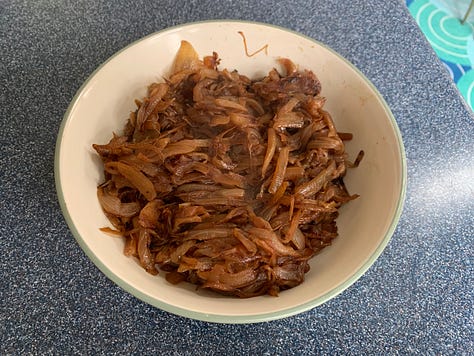
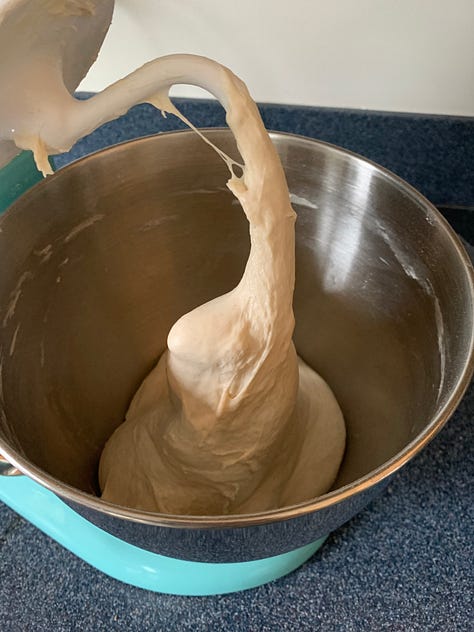
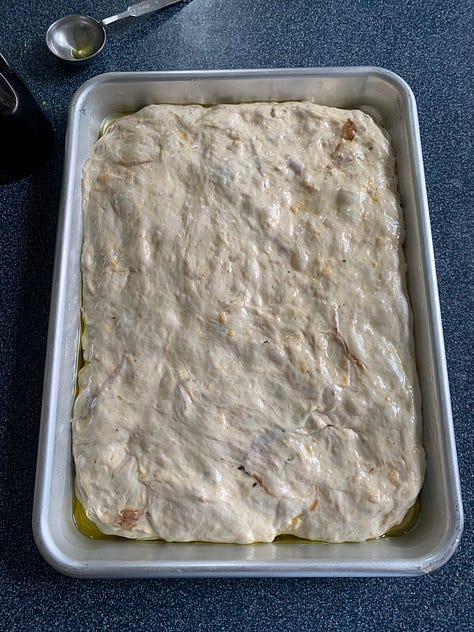
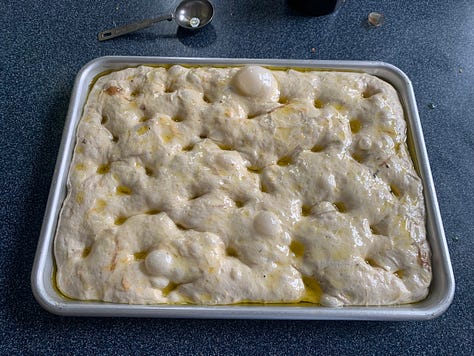
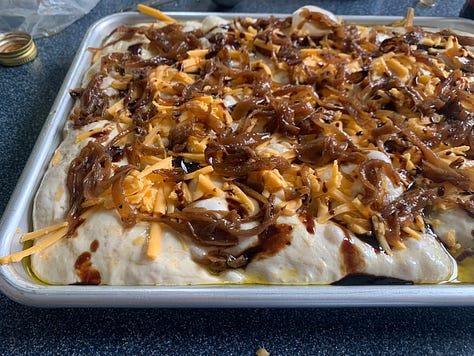
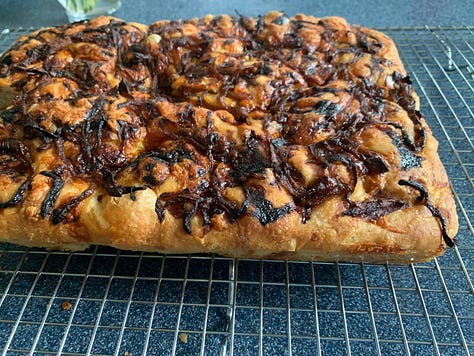
The story
High on my vanilla cake success, I decided to make my husband the perfect focaccia. He loves crunchy textures and unique flavor combinations, so I decided on a caramelized onion, sharp cheddar, and pomegranate molasses bread. The focaccia would be pillowy soft in the middle, and the top and bottom would have a crispy crust. I’d achieved perfection once; I had this in the bag.
The first batch was just fine, but I don’t expect everything to go right on a first attempt. The middle was soft, and the topping tasted great. But the bottom wasn’t crunchy and the middle of the bread tasted bland next to the flavor bomb of the onions and cheese. I denied this was actually the case until my husband asked if I could incorporate some toppings into the middle of the bread. Focaccia doesn’t unsually have any flavor aside from the toppings, and that might be for a reason, but I could give it a shot and see what happened. No problem.
I tried again. I added half the onions and cheese into the dough before kneading it in the mixer. Turns out, when you knead soft onions and shredded cheese at medium-high speed for a full 10 minutes, they turn to mush and get absorbed into the dough. The bread itself tasted good, but it had a weird, spongy texture. Well, at least I’d learned something, and it would probably be an easy fix.
For the third attempt I added the onions and cheese at the last minute of mixing, and I baked it longer to crisp the bottom. Much better. Onions and cheese were evenly distributed and they remained intact. Flavor throughout the bread: check. But the bottom was still soft. Not what I expected. I’d made crispy focaccia before by using this method. Was something off with my bread intuition? Well, I had been on a caffeine high when baking this loaf, and I miss things when I rush. I double-checked my notes, and sure enough, the oven temperature was too low. That was dumb. Now I needed to make another whole batch because of it. I took a deep breath. I could do it. Attempt 4 is usually the point at which I succeed.
I tried again. Instead of 425°, I baked attempt 4 at 450°, on the bottom rack, for 30 minutes. It had a delicious flavor, just a touch of acidity from the pomegranate molasses, and strong umami from the onions. The interior was soft and springy, and the edges were crisp. But the bottom still wasn’t crunchy. And I was out of onions. I had caramelized an entire three-pound bag of them at the beginning of the week, and they were gone. It would take a half hour of browning new onions at the stove before I could bake the next loaf, but I was definitely fine with that. I didn’t mind at all. No problem.
For attempt 5, I would get the crust crunchy, no matter what it took. I would give my husband the bread of his dreams. The oven went on 450° again, the bread went on the bottom rack, I doubled the amount of olive oil on the baking sheet so that the dough would really fry in it, and I baked it for a full 40 minutes, 10 longer than the previous batches. I took the bread out of the oven, lifted it off the baking sheet, and was relieved to see that the bottom was brown and finally felt crisp.
I took a close look at the top, and the onions were a little darker than they should have been. Hmm. I tried one and it was so bitter I spit it out. I lamented about it to my husband, and he promised he would still enjoy the focaccia. To prove it he took a bite… and immediately asked me to pick the burned onions off before it went in the freezer. He also wondered, what would happen if for the next batch I put some foil over the top of the bread during the last 10 minutes of baking to keep the onions from burning? Would that get me the bread I was after? “NO!” I shouted at him. “I am NOT baking another batch of this stupid focaccia! In fact, I am NOT baking bread for a long time. You’re just going to have to be fine with it not being crispy on the bottom! You can’t always have your cake and eat it too, BC!” He, wisely, kept his mouth shut and continued munching.
I still haven’t worked up the enthusiasm to bake bread again. Batch 4 was the best of my attempts, so that recipe is the one I wrote up for this newsletter. And if I had to settle for an imperfect recipe this time around, then you do, too.
Spread the Snob
If you like this recipe, please recommend Confessions of a Cake Snob to someone you know! Follow me on Pinterest or Instagram for more ways to view and save the recipes. Please share this newsletter with a friend, comment on the website, or bake it and let me know how it went for you! Email me with comments, ideas, and suggestions at confessionsofacakesnob@substack.com.



